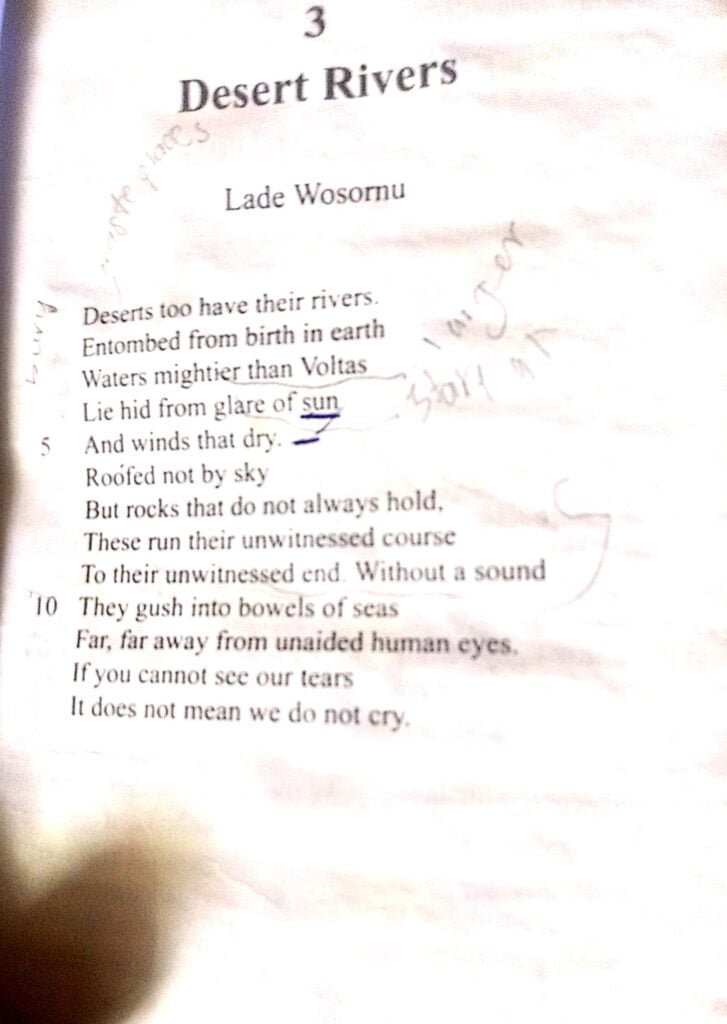Desert Rivers

Meaning of words used In-the poem (synonyms)
Deserts (line 1): waste places, the wilderness, dry and sandy lands, desolate.
Entombed (line 2): bury, place in the grave.
Mightier (line 3): stronger, larger, greater, impressive.
Glare (line 4): brightness, stare at, dazzle, brilliant.
Unwitnessed (line 8): not seen, private, isolated, secluded.
Gush (line 10): flood, pour out, surge, flow
Bowels (line 10): huge receptacles, guts, insides, in the deeps
Issues the poem raises
It is marvellous that water bodies lie beneath the surface of the earth, and this should not be taken for granted but should be counted as a natural resource and a blessing.
Theme
- If a dry desert ground can entomb water, then there is hope in every seemingly hopeless situation.
- The value of a person may be hidden from other people (as desert river may be hidden from the sky and buried under rock), but that value is very much present.
- Many people may be hurting in the larger society that we live in, but their plight may be unknown, so they would be suffering silently
If you cannot see our tears / It does not mean we do not cry (last line).
Literary devices
Personification: winds that dry (line 5); rocks that can roof (lines 6 and 7);
Alliteration:….unwitnessed courses … unwitnessed end (lines 8 and 9). Note the repetition of consonant sounds.
Rhyme: Lines 5 and 6 rhyme on…. dry (line 5) and… sky (line 6). The line, “entombed from birth in earth” creates rhyming sound on “birth” and “earth”.
Hyperbole:… Without a sound/ They gush into bowels of seas is an example of a hyperbole (meaning exaggeration) because underground water will rather seep (or ooze) gently to the sea, not gush (meaning rush) into it.
Imagery: Water rushing underground and discharging its content into the sea paints the picture of haste and urgency Metaphor:… bowels of seas (line 10) represents the
belly of the sea. The sea has no bowels (that is, entrails or intestines), but the word is used metaphorically to represent the sea’s stomach.
Simile: Waters mightier than Voltas (line 3).
Tone
The poet sounds assertive, as if he has to make a point that people might dispute. So he uses a strong imagery to prove that although his situation may not be as laudable as others he nevertheless has something going for him: The water in his desert rivers is mightier than the Voltas of the world. His tone is also serious.
Form or of the poem Desert Rivers is a one-stanza poem consisting of thirteen lines that don’t rhyme. Thus, it’s a free verse. The varying length of lines presents a variety of rhythm and tone.
Commentary and analysis
Some elements are not seen, and just because they cannot be seen does not mean they don’t exist. The poet identifies one of life’s important and indispensable resources: water, and insists that under the earth, deep below the surface where no human eyes can see, lies a large collection of water, (For example, no human eyes can see God, but God does exist and is constantly involved in the affairs of humanity).
The poet explores one of human weaknesses; that is, the failure to acknowledge others for what they have, just because what they have is different from ours. Look at a person, not from the outward but also the inward, for, lying behind what
we don’t see may be values that must be acknowledged Big rivers like the Voltas may pride themselves with majesty for their size, volume, and value (like occupational Bhing and water transport), which the underground water may tack, but desert rivers can have something to boast about. For it is spared of “winds that dry” (line 5). In fact, “desert rivers are those that burst out with spring water and create oasis in the desert.
In a symbolic sense, the poet encourages people who may look down on their own efforts. The water that is buried deep beneath the earth is “mightier than Voltas” (line 3). The water “he hid from glare of sun” – that is, the sun does not see the water, neither do other human beings. Even if people around you don’t notice your worth or value, don’t get discouraged, for you too are making a worthwhile contribution in society. For the water
To their unwitnessed end. Without a sound
… run their unwitnessed courses They rush into bowels of seas Far, far away from unaided human eyes
(lines 8-11).
Note the various types of “water” used in the poem: rivers, waters, Voltas (River Volta and its tributaries), seas, tears. Water symbolises life. The underground river is hidden under rocks, but those rocks “do not always hold” (line 7) it, so it gushes out and flow into the seas. This description gives the poem a fast-paced movement, like the swift flow of rivers.
The title of the poem reveals what may seem like a contradiction but which rather shows hope. Desert Rivers: A desert is a dry place, full of sand and arid conditions, wasted soil that is largely barren. Symbolically, “desert” points to
12
3
unproductive and abandoned situations. Yet, in this rather di mal environment, water may be found. While desert symbolis fruitlessness, water- symbolises life and fruitfulness. Surface wa ter (rivers, lakes, ponds) are subject to the elements, “sun” and “wind”, but the underground river is spared these challenges. So the poet alludes to hope in a hopeless situation. No matter how hopeless life may seem to be, there is always hope as long as there is life. Deserts too have their rivers. Although the river (the objects of hope)
may be far away, not so obvious, (unwitnessed) they are there. and they are “mightier than Voltas”. The mention of the Volta Ghana’s longest and more prominent river, gives the poem a setting, contextualising it to Ghana’s landscape.
The last two lines of the poem contain a vibrant point the poet makes. Note the reference to “tears” and “cry”. He is making reference to suffering in the land where some people groan in silence. People may be hurting in the large society that we live in, but they may be suffering silently. If you cannot see our tears it does not mean we do not cry (last line).
Discussion Questions
1. If deserts too have their rivers, where are the rivers? 2. How does the poet describe the underground water?
3. What image does the reference to “Voltas” convey? 4. What is the theme of this poem?
5. What advantage has the rivers that are entombed? 6. What is said to “run their unwitnessed course”?
7. Find any two places that rhyming is found in the poem.
8. Identify any three literary devices used in the poem. 9. Name two issues that the poem raises.
10. Complete this line and state how you understand it: If you cannot see our tears…
